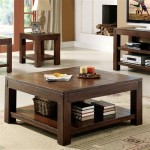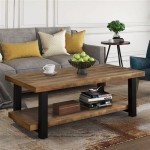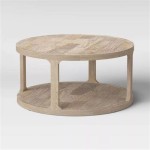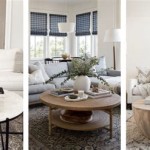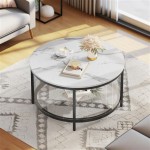Selecting the Perfect Coffee Table for a Neutral Living Room
A neutral living room provides a versatile and calming foundation for any home. This design aesthetic, characterized by muted tones such as beige, gray, cream, and white, allows for flexibility in accessorizing and a sense of timeless elegance. The coffee table, often positioned as the centerpiece of the room, plays a critical role in defining the space's style and functionality. Therefore, carefully selecting a coffee table that complements the neutral palette and serves the intended purpose is essential.
The impact of a coffee table extends beyond its utilitarian function of providing a surface for drinks, books, and decorative items. It can significantly influence the overall ambiance and visual harmony of the room. Choosing the right material, shape, size, and style contributes to a cohesive and aesthetically pleasing environment. A poorly chosen coffee table, on the other hand, can disrupt the flow of the room and detract from its intended design.
When embarking on the search for the ideal coffee table for a neutral living room, several factors require careful consideration. These range from practical considerations like size and storage to aesthetic aspects such as material and shape. By thoughtfully evaluating these elements, homeowners can confidently select a coffee table that not only enhances the room's visual appeal but also serves its functional purpose effectively.
Considering Size and Proportion
The size of the coffee table must be proportional to the size of the living room and the surrounding furniture. A coffee table that is too large can overwhelm the space, making it feel cramped and cluttered. Conversely, a coffee table that is too small can appear insignificant and fail to provide adequate surface area. An optimal coffee table length should be approximately two-thirds the length of the sofa. This ensures a balanced aesthetic and comfortable reach for those seated.
Furthermore, the height of the coffee table is crucial for both functionality and visual appeal. Ideally, the coffee table should be the same height as the sofa cushions or slightly lower. This allows for comfortable placement of items and prevents an awkward visual disparity. A coffee table that is significantly higher than the sofa can feel cumbersome and impede conversation. The proximity to the sofa also dictates suitable height; ensure there is enough space for comfortable legroom when moving around the seating arrangement.
Before purchasing, carefully measure the available space and consider the layout of the furniture. Using painter's tape to mark the potential footprint of the coffee table on the floor can provide a visual representation of its size relative to the existing furniture. This helps to prevent costly mistakes and ensures that the chosen coffee table fits seamlessly into the living room.
Beyond the surface area, the vertical volume of the table also influences the perception of space. Open-frame designs or tables with slender legs contribute to an airier, less obstructed view compared to solid, bulky constructions. In smaller neutral living rooms, maintaining visual lightness is key to preventing the space from feeling enclosed.
Selecting the Right Material and Finish
The material of the coffee table significantly impacts its durability, style, and overall aesthetic. In a neutral living room, materials that complement the muted color palette and add texture are particularly effective. Popular choices include wood, glass, metal, and stone, each offering unique characteristics and visual appeal.
Wood is a versatile and timeless choice, offering warmth and natural beauty. Light-toned woods such as oak, maple, and birch can enhance the airy and inviting atmosphere of a neutral living room. Darker woods like walnut or mahogany can add a touch of sophistication and contrast, but should be used judiciously to avoid overwhelming the space. The finish of the wood also plays a crucial role. A matte or satin finish can create a more subtle and understated look, while a glossy finish can add a touch of glamour.
Glass coffee tables offer a modern and minimalist aesthetic. Their transparency allows light to pass through, creating a sense of spaciousness and openness. Glass is also easy to clean and maintain, making it a practical choice for busy households. However, glass can show fingerprints and scratches, so regular cleaning is necessary. Tempered glass is recommended for safety and durability.
Metal coffee tables provide a sleek and contemporary look. Options include stainless steel, brass, and wrought iron. Stainless steel offers a clean and modern aesthetic, while brass adds warmth and a touch of luxury. Wrought iron can create a more rustic or industrial feel. Metal can be combined with other materials, such as wood or glass, to create visually interesting and unique designs. Powder-coated finishes offer a durable and easy-to-maintain surface.
Stone coffee tables, such as marble or granite, provide a luxurious and sophisticated touch. These materials are durable and resistant to heat and stains. However, stone can be heavy and expensive. Lighter-colored stones, such as white marble or light gray granite, are particularly well-suited for neutral living rooms. The veining patterns in natural stone add visual interest and character.
When choosing between materials, consider the existing furniture and décor in the room. Aim for a cohesive look that complements the overall style. Mixing different materials can create visual interest, but it is important to do so thoughtfully and intentionally.
Considering Shape and Design Style
The shape of the coffee table is another important consideration that impacts the room's aesthetics and functionality. Common shapes include rectangular, square, round, and oval, each offering unique benefits and visual characteristics. The ideal shape depends on the size and layout of the room, as well as the style of the surrounding furniture.
Rectangular coffee tables are a popular and versatile choice, particularly well-suited for larger living rooms with sofas of similar length. They provide ample surface area and create a sense of balance and symmetry. A rectangular coffee table can be effectively used to define the seating area and create a focal point in the room.
Square coffee tables are well-suited for smaller living rooms or seating areas with symmetrical layouts, offering a compact and balanced look. They work well with sectional sofas or two armchairs facing each other. A square coffee table can create a cozy and intimate atmosphere.
Round coffee tables soften the lines of a room and create a more relaxed and inviting atmosphere. They are particularly well-suited for smaller spaces or rooms with curved furniture. Round coffee tables promote better traffic flow and prevent sharp corners that can be hazardous. They encourage conversation by allowing people to face each other more directly.
Oval coffee tables offer a similar aesthetic to round tables but provide a slightly larger surface area. They combine the softness of a round shape with the practicality of a rectangular shape. Oval coffee tables work well in a variety of living room layouts and styles.
The design style of the coffee table should complement the overall aesthetic of the neutral living room. Popular styles include modern, minimalist, traditional, rustic, and bohemian. A modern coffee table typically features clean lines, simple shapes, and minimal ornamentation. A minimalist coffee table emphasizes functionality and understated elegance. A traditional coffee table often incorporates classic details and ornate carvings. A rustic coffee table features natural materials and a weathered finish. A bohemian coffee table embraces eclectic patterns, textures, and colors.
Consider the storage needs of the living room when selecting a coffee table. Some coffee tables offer built-in storage options, such as drawers, shelves, or hidden compartments. These can be useful for storing books, magazines, remote controls, and other items. A coffee table with storage can help to keep the living room clutter-free and organized.
Ultimately, the choice of coffee table shape and design style should reflect personal preferences and complement the existing décor. Experiment with different options to find the perfect fit for the neutral living room.
Beyond the core considerations of size, material, and shape, various design elements can further enhance the coffee table's integration within a neutral living room. These include leg style, edge detailing, and the incorporation of subtle textures or patterns. A coffee table with tapered legs contributes to a more streamlined and modern appearance, while ornate, carved legs lean towards a traditional aesthetic. Rounded edges offer a softer, more forgiving profile, particularly beneficial in homes with young children. Similarly, incorporating textural elements like woven detailing, subtle wood grain patterns, or lightly distressed finishes can add depth and visual interest to a neutral palette without overpowering the space. The careful selection of these smaller details can elevate the coffee table from a functional item to a key design element that seamlessly blends with the overall aesthetic of the living room.
The interplay of light and shadow on the coffee table's surface can also contribute to its visual impact. A coffee table with a reflective surface, such as glass or polished metal, can amplify the natural light in the room, creating a brighter and more airy atmosphere. Conversely, a coffee table with a matte finish can absorb light, creating a more subdued and intimate ambiance. The placement of the coffee table relative to windows and light fixtures should be considered to maximize its impact on the overall lighting scheme of the living room. Furthermore, the choice of accessories placed on the coffee table can also influence its perceived brightness; lighter-colored objects will reflect more light, while darker objects will tend to absorb it. A well-curated selection of accessories can help to balance the light and shadow on the coffee table, creating a visually appealing and balanced focal point.

Cozy Sitting Room Neutral Living Woods And Whites

Neutral Living Room Crate Barrel

Best Ideas To Style A Warm Neutral Living Room 2025

Styling An Updated Looking Coffee Table In 5 Easy Steps Stonegable

Guide To Choosing The Best Coffee Table For Your Living Room Np

Astonishing Neutral Living Room By Serhat Sezgin Modern Furniture Caffe Latte Home

Coffee Table Decor Styling And Arrangement Ideas For 2025 Jane At Home

Coffee Table Decor Visionary Homes

How To Style Your Coffee Table The Oak Furnitureland Blog

35 Neutral Living Room Ideas That Are Anything But Plain
